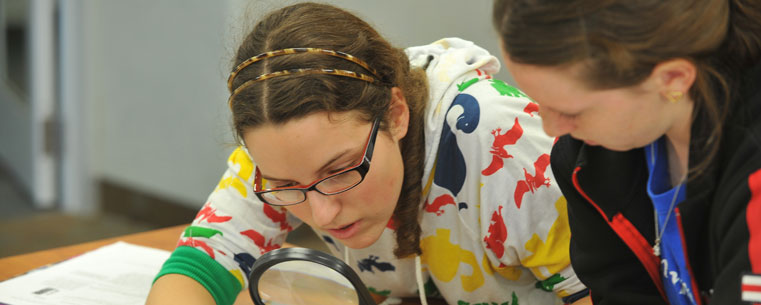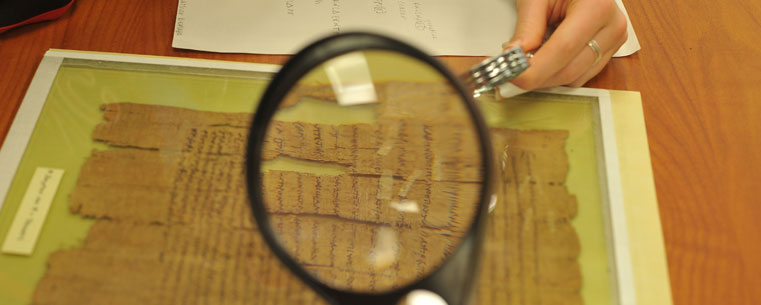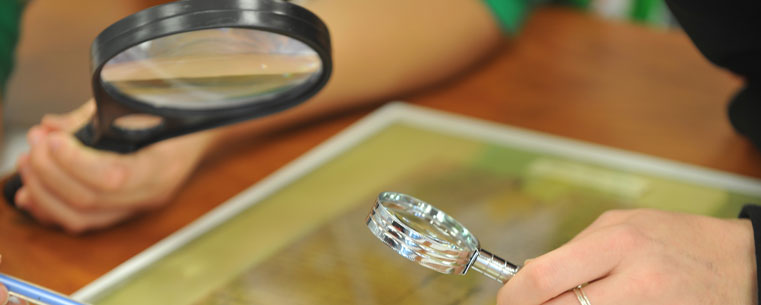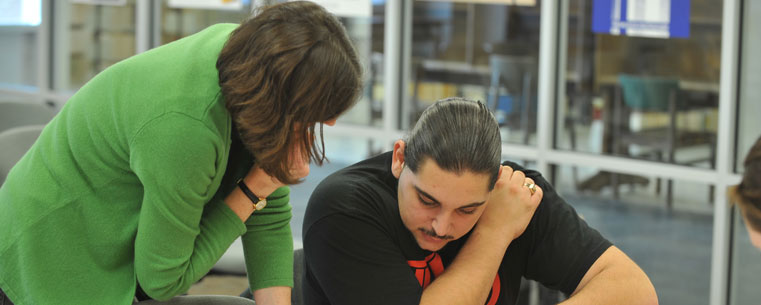Recent Success Stories
- New Kent State President Embarks on Listening Tour
- Scholar Helps Fight Crime With Violence Prevention Research
- Welcome, President Warren
- Destination
Kent
State
Returns - Now Serving More Than 300 Student Organizations
- Visit Kent State
- Kent State Captures Eighth Jacoby Trophy
- Scholar Supplies Global Technology Knowledge to Students





Kent State Students
Study Ancient
Papyrus
Four ambitious Kent State students have the rare opportunity to study an ancient Greek papyrus as part of an innovative program designed to mentor undergraduate students in the research and publication of ancient texts.
Dr. Jennifer Larson, chairperson and professor of classics in the Department of Modern and Classical Language Studies, heads the project for the university. When Larson received a call from Dr. Scott Carroll inviting Kent State to participate in the Green Scholars Initiative (GSI), she was thrilled and surprised.
Carroll is the director of the Green Collection, one of the world’s largest private collections of manuscripts, papyri and cuneiform tablets. The collection is owned by Steve Green, president of Hobby Lobby Stores. Carroll travels the world acquiring items for the collection, which is valued at up to $40 million and will eventually be housed in a non-sectarian Bible museum.
The Green Scholars Initiative is an international project to involve undergraduate students in the publication of items from the massive archive. Larson, whose expertise is in ancient Greek culture and literature, had never participated in a project of this type before – but jumped at the chance to involve Kent State students in the challenge.
Four Honors College students were recruited to be a part of Larson’s GSI class through an essay competition. The students, who had to agree to take elementary Greek classes, receive 2 credits per semester for their work.
The papyrus arrived at Kent State in August enclosed in a glass case. Internal grants from the University Research Council and the College of Arts and Sciences provided the incidental funds necessary to bring the valuable antiquity to the university.
“When I finally had the papyrus in front of me, I thought of all of the history classes I’ve taken, and all of the times looking at pictures of artifacts in books,” says philosophy major Tommy Walsh. “Now there is something in front to me from almost 2,000 years ago. We are dealing with a piece of history. It was an amazingly intense feeling.”
Walsh and student colleagues Heather Benya, Ola Sobieska and Kayla Zatezalo are making new discoveries on an almost weekly basis. “Dr. Carroll told us the papyrus was probably from the Egyptian city of Oxyrynchus and we were going on that assumption,” Larson explains. “But now that we are reading it, it looks like it may be from Tebtunis, a city north of Oxyrhynchus.”
Carroll did not provide a date for the papyrus, but Larson’s team has already determined that it’s from 44 A.D., during the reign of the emperor Claudius.
Ancient history scholar Dr. Jerry Pattengale, a noted author and assistant provost at Indiana Wesleyan University, leads the GSI. “Pattengale does a lot of work with experiential learning, and that really is the focus of this project,” Larson says.
Approximately 200 students nationwide are currently participating in the GSI. Twelve institutions are collaborating on papyri from the collection.
Larson says the groundbreaking program provides a rare opportunity for undergraduate students. “It turns everything upside down,” Larson says with a laugh. “Work on a very specialized document like this is usually reserved for senior professors and Ph.D. students.”
Benya, a sophomore mathematics major, said she was “floored” when she found out she was chosen to participate in the project.
“I could only dream of being able to handle an original ancient Greek document at the age of 19,” Benya says. “I am so honored to be a part of the team that is identifying and publishing the ancient Greek papyri, and also to be able to work with Dr. Carroll and Dr. Larson.”
The four students will work on the project through this academic year. “If it takes longer to arrive at a publishable version, they are welcome to continue working on it with me,” Larson explains. There is no set timetable for publication, but students will receive a publication credit.
“There’s nothing as motivating as working with an actual ancient artifact,” Larson says. “It’s so exciting for them, and every day we discover something new and that excites them all the more.”
Items from the Green Collection are featured in the exhibit “Passages: The 400th Anniversary of the King James Bible,” which opens Nov. 19 in Atlanta and will eventually visit cities around the world. Given that there are enough unpublished documents in the collection to keep scholars around the country busy for decades, Larson says there may be opportunities for future Kent State students.
“It’s my hope that when this project is done, they will send us another document we can work with,” Larson says.
Find more information on Kent State’s Department of Modern and Classical Language Studies.

Facebook
Twitter
Google+
LinkedIn
Instagram
YouTube
More Ways to Connect